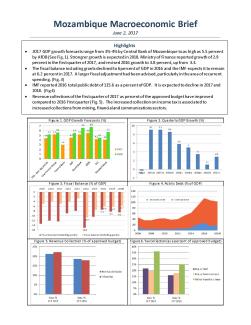USAID/Mozambique Macroeconomic Brief, prepared quarterly.
June 2017 Release - Highlights
- 2017 GDP growth forecasts range from 3%-4% by Central Bank of Mozambique to as high as 5.5 percent by AfDB (See Fig. 1). Strongrer growth is expected in 2018. Ministry of Finance reported growth of 2.9 percent in the first quarter of 2017, and revised 2016 growth to 3.8 percent, up from 3.3.
- The fiscal balance including grants declined to 6 percent of GDP in 2016 and the IMF expects it to remain at 6.2 percent in 2017. A larger fiscal adjustment had been advised, particularly in the area of recurrent spending. (Fig. 3)
- IMF reported 2016 total public debt of 115.6 as a percent of GDP. It is expected to decline in 2017 and 2018. (Fig 4)
- Revenue collections of the first quarter of 2017 as percent of the approved budget have improved compared to 2016 first quarter (Fig. 5). The increased collection on income tax is associated to increased collections from mining, financial and communications sectors.
- International Reserves have increased since October 2016, reaching over US$2 billion in March. In 2014, reserves almost reached US$3.5 billion (Fig. 7). IMF reports in the May 2017 Regional Economic Outlook that reserves in months of imports reached 3 for the year 2016 and expects a decline to 2.3 this year.
- Commodity prices reported by the World Bank show increase prices of Aluminum and Coal since the third quarter of 2016; these are two of Mozambique’s main exports. Coal is expected to average $70/ton in 2017
- In the UNCTAD May Global Investment Trends Monitor, it is reported that Mozambique saw its FDI inflows fall for the third consecutive year and to a six year low of $3 billion, declining 20 percent from 2015. The IMF forecasts a decline this year and a strong recover in Net FDI in 2018, reaching over 50 percent of GDP (Fig. 10).
- Domestic credit growth has declined across the different sectors since August of last year and had reached negative growth in the tourism sector since November 2016 (Fig. 11). With the change in the Central Bank Monetary policy tightening, an increase in domestic credit growth is expected.
- Inflation is expected to decline to as low as 12 percent (Central Bank) in 2017 and continue declining in 2018 (Fig. 12), but others such as EIU (19.4%) and Standard Bank (17.7%) expect still higher inflation.
Please view PDF attachment for full details and figures.
(331.73 KB)

